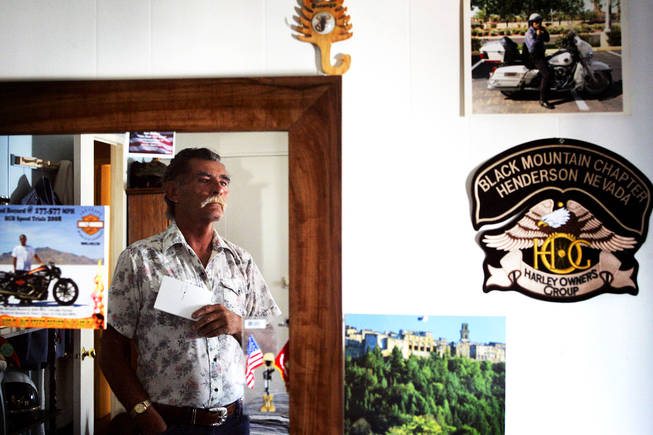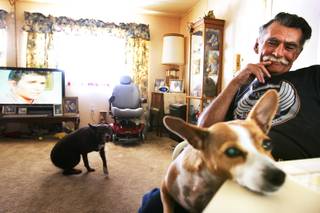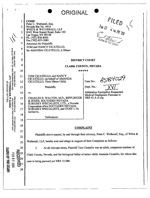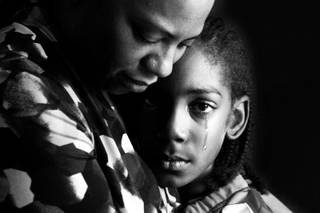
Don Carlson looks at memorabilia from his biking days, before a hospital-acquired infection after surgery to remove a tumor cost him his security guard job.
Sunday, Dec. 26, 2010 | 2 a.m.
Do No Harm: Hospital Care in Las Vegas, Part 5
- Sun investigation reveals flaws in hospital care; solutions offered
- How to put patients first
- Local hospitals’ willingness to change culture would be a step toward better care, transparency
- ‘You can’t kill my mother and get away with it’
- We must adopt a culture of sincere care
- How to file a complaint
Share your stories
Do No Harm: Brian Greenspun
Sun Publisher and Editor Brian Greenspun talks about the findings of the newspaper's series on hospital care. To address the problems raised by the series will require a change in attitude from executive suites down, including more openness with patients and a commitment to do no harm.
It’s too late to protect Don Carlson, who was almost killed by a deadly infection he contracted in a Las Vegas hospital. The lengthy recovery cost him his security guard job, and now he’s in bankruptcy.
There’s no erasing Regeena Draizen’s scars. Her surgeon accidentally plunged a surgical device through her aorta during an appendectomy, nearly killing her.
And no one can bring back Morry Janovitz, who died after falling and breaking his neck in the hospital, or Dickson Clark and Donald Arthur Rowan, who were killed by hospital-acquired infections.
But future Las Vegas hospital patients can be protected if doctors and hospitals commit to do no harm.
Others across the country have made that pledge. The New Hampshire Hospital Association in September launched a five-year campaign to stop hurting patients in ways that lead to complications, disability or death. The Tennessee Hospital Association pledged in 2009 to eliminate preventable harm, starting with a focused effort to reduce hospital-acquired infections. The University of Illinois Medical Center in Chicago has no tolerance for patients being injured or infected on its premises. Neither does Kent Hospital in Warwick, R.I.
But Las Vegas hospital leaders seem resigned to patient-care problems, even after the Sun published the findings of its two-year investigation that found thousands of incidents of patient harm in Las Vegas hospitals in 2008 and 2009.
“You’re looking at the problems in Las Vegas and saying there are problems here. No one is denying that,” said Dr. Ron Kline, president of the Nevada State Medical Association, of the Sun’s investigation. “But the argument would be that those similar problems exist in other places. To some degree you can’t eliminate them.”
Dr. Mitchell Forman, president of the Clark County Medical Society, took offense at the Sun highlighting individuals to show the human toll of poor hospital care. He wrote in his October society newsletter that the Sun’s articles “exploit the ‘facts’ by presenting sensational and distorted case reports that tug at the heartstrings of those who read these accounts … It takes the raw (datum) and connects it to people.”
At least Kline and Forman would discuss the problems. The Sun has repeatedly requested interviews with every Las Vegas hospital CEO to discuss patient safety, and all but two refused.
“There’s an awful lot of denial,” said Larry Matheis, executive director of the Nevada State Medical Association. “The type of stories you’re doing have to be done in order to change the conversation. That’s working. The next thing is to get the buy-in that something can be done about it. Then you can get the culture change.”
But outside the medical community, the responses have come quickly. The Sun’s investigation into hospital care, unprecedented in its scale and scope, has triggered health care changes and promises of additional efforts during the 2011 Legislature.
The foundation for the project was an analysis of inpatient hospital billing records on file with the state, providing the first public picture of the scale of harm taking place in hospitals.
The Sun found that among Las Vegas hospitals in 2008 and 2009:
• 969 people suffered preventable bedsores, falls that result in broken bone, infections and other injuries.
• 2,010 patients were infected with deadly drug-resistant bacteria.
• 710 patients suffered preventable surgical injuries.
In the 3,689 cases identified by the Sun, 356 patients died in the hospital. It’s impossible to say from the billing records how the harm contributed to the deaths.
The Sun supported its findings with interviews with more than 60 patients who were harmed in Las Vegas hospitals and more than 200 doctors, nurses, hospital administrators and other experts.
The newspaper found Las Vegas is more concentrated with for-profit hospitals than any urban area in the country, and is the only city of its size or larger with no academic medical institution. In addition, short staffing of nurses is rampant, peer review by doctors is virtually nonexistent and hospitals routinely cover up cases of harm when they should be identifying them for the purpose of improvement.
The Sun’s findings, undisputed by the hospitals, were buttressed last month when the federal government reported that about one in four Medicare patients suffer harm in hospitals, and about half the cases could be prevented. The report estimated the harm caused 15,000 deaths a month among Medicare patients.
In the wake of the Sun’s revelations:
• The Nevada State Health Division, which licenses hospitals and inspects the facilities, is investigating whether hospitals have underreported their sentinel events — unexpected infections or injuries to patients — as the newspaper found. The Health Division is using data analyzed by the Sun for its inspections and epidemiological investigations.
• The three St. Rose Dominican Hospitals and publicly owned University Medical Center broke ranks with other Las Vegas hospitals by posting previously unreported patient-outcome data on their websites.
• In November, more than 200 health care providers and consumer advocates attended a state-sponsored summit to fight the deadly bacteria methicillin-resistant Staphylococcus aureus, known as MRSA. The state announced grants up to $30,000 for health care facilities to reduce infections.
• The Health Services Coalition, a group of two dozen self-insured companies representing 240,000 patients in Las Vegas, is aggressively leaning on hospitals to improve patient care. Its website, bettercarenow.org, pressures hospitals to improve by disseminating quality information and patient reviews of hospitals to its members.
Concurrently, elected officials are drafting legislation to address issues identified by the Sun. State Sen. Shirley Breeden, D-Henderson, wants state law to push hospitals to be more candid about infection rates by posting them in public areas, such as near elevators.
And state Sen. Sheila Leslie, D-Reno, said she will propose a law requiring hospitals to publicly report not just the number of infections that occur in their facilities but also the number of sentinel events. Current law requires only that information be reported in a statewide aggregate, not by hospital.
“No one is going to want to see their hospital listed with more sentinel events than others,” Leslie said. “Public pressure to do better than your competitors is going to improve health care quality for everyone.”
Kline and Forman support greater hospital transparency.
“It gives consumers the information to make an educated and informed decisions,” Kline said. “And it’s a good thing because, human nature being what it is, the hospital that is not doing well will be driven to improve.”
Matheis is resurrecting a 2009 proposal to consolidate dozens of licensing boards, including those for doctors and nurses, as is done in 26 states. The move would improve accountability and eliminate the conflicts of interest that undermine disciplinary efforts. Physicians on the board have been accused of being overly accommodating with peers who faced discipline, at the expense of public safety.
Assemblyman Richard “Tick” Segerblom, D-Las Vegas, said he will introduce a bill to force disclosure of how much money private hospitals are making on behalf of their out-of-state owners. UMC is the only locally owned hospital in the Las Vegas Valley.
“People from out of state treat us like a colony,” he said. “They fight to keep us from raising their taxes and then take their profits elsewhere.”
Other reforms proposed in the past could be implemented now. In 2002 a legislative committee recommended changes to improve patient safety that were largely ignored, according to John Yacenda, a former Nevada Health and Human Services administrator who lead the panel.
The committee recommended creating the Nevada Alliance for Patient Safety, which would have, among other things, identified and implemented best practices to prevent medical error and train providers and the public about the problems.
No entity fulfills that function in Nevada, where hospitals are more focused on competing than collaborating. Creating a similar partnership among hospitals was crucial to bringing about improvements in New Hampshire.
“It’s all about sharing best practices and working together to find out how everybody can improve,” said Andrea Alley, New Hampshire Hospital Association spokeswoman.
The 2002 committee also recommended that each health care facility would provide to patients, at the time they are admitted, information about their rights and the contact information for oversight agencies for doctors and hospitals.
The committee said legislators should ensure that state regulators receive adequate funding to perform annual on-site inspections of health care facilities. Failing to do this contributed to a Las Vegas clinic becoming the source of the largest hepatitis C outbreak in the nation in 2008. That funding was approved by legislators in 2009, based on fee increases. In October a different panel of legislators rejected the fee increases, which leaves the state without enough inspectors to monitor facilities.
Yacenda said the recommendations did not pass in the 2003 legislative session because of failed leadership and the influence of hospital lobbyists who resisted the intrusion into their business.
Leslie said the 2002 proposals have merit.
Scores of injured hospital patients interviewed by the Sun implored hospital CEOs, board members and doctors to be more attentive to patient-safety problems.
Among them is Tina Sigman, who was recovering from a Caesarean section in May 2008 when she became sick from fumes leaking into her room from the hospital’s helicopter pad. She said no one at the hospital responded to her complaint letter.
Today, Sigman says she has a message for the hospital community: “Please remember that we’re human beings. We just need for you to care about us.”
Sun photographer Leila Navidi contributed to this story.





Join the Discussion:
Check this out for a full explanation of our conversion to the LiveFyre commenting system and instructions on how to sign up for an account.
Full comments policy